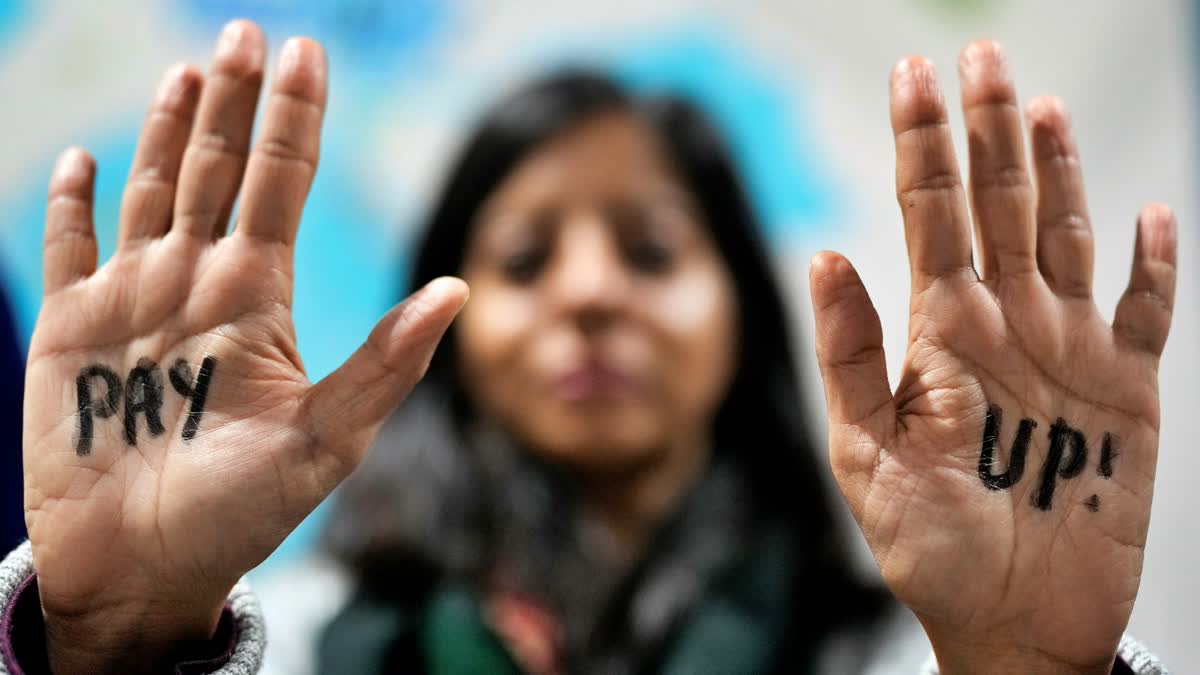New Delhi:India on Sunday was at the forefront of rejecting the deal at United Nations climate talks to inject $300 billion annually to help developing nations cope with the ravages of global warming.
The deal reached at the UN climate talks in Baku in Azerbaijan ramps up the money that wealthy historic emitters will provide to help poorer nations transition to cleaner energy and adapt to global warming.
Making a statementon behalf of India, Chandni Raina, Adviser, Department of Economic Affairs, said they were not allowed to speak before the adoption of the deal, undermining their trust in the process. “It’s a paltry sum,” Raina said, repeatedly saying how India objected to rousing cheers. “I’m sorry to say we cannot accept it.”
"In continuation of several such incidents of not following inclusivity, not respecting country positions... We had informed the presidency, we had informed the secretariat that we wanted to make a statement prior to any decision. However, this is for everyone to see, this has been stage-managed. We are extremely disappointed," she said.
"The goal is too little, too distant," Raina said, asserting that it is set for 2035, which is too far away. "Estimates tell us that we need at least USD 1.3 trillion per year by 2030," she said.
Here are the main points of the agreement reached at COP29
$300 billion per year by 2035
Under a framework established by the UN in 1992, 23 developed countries -- and the European Union -- historically responsible for most planet-heating emissions are obliged to contribute to climate finance.
The Baku accord raises the amount of money that developed countries must provide to at least $300 billion per year by 2035. It is higher than the $100 billion that is currently required under a previous agreement that runs until next year. But it falls well short of the $500 billion that some developing countries had demanded at the fraught negotiations in Baku.
The deal states that the money will come directly from a "wide variety of sources" including government budgets, private sector investment, and other financing. It also cites "alternative sources" -- a reference to potential global taxes under discussion on the aviation and maritime industries, and the rich.
The hope is that the money from developed countries will help boost private investment to reach an ambitious goal -- written into the deal -- of delivering at least $1.3 trillion per year by the next decade. That is the amount that experts commissioned by the United Nations said was needed by 2035.
"With these funds and with this structure, we are confident we will reach the 1.3 trillion objective," EU climate commissioner Wopke Hoekstra told fellow COP29 delegates.
The agreement is also a critical step toward helping countries on the receiving end create more ambitious targets to limit or cut emissions of heat-trapping gases that are due early next year. It’s part of the plan to keep cutting pollution with new targets every five years, which the world agreed to at the U.N. talks in Paris in 2015.
The Paris agreement set the system of regular ratcheting up climate fighting ambition as away to keep warming under 1.5 degrees Celsius (2.7 degrees Fahrenheit) above pre-industrial levels. The world is already at 1.3 degrees Celsius (2.3 degrees Fahrenheit) and carbon emissions keep rising.
What will the money be spent on?
The deal decided in Baku replaces a previous agreement from 15 years ago that charged rich nations $100 billion a year to help the developing world with climate finance.
The new number has similar aims: it will go toward the developing world's long laundry list of to-dos to prepare for a warming world and keep it from getting hotter. That includes paying for the transition to clean energy and away from fossil fuels. Countries need funds to build up the infrastructure needed to deploy technologies like wind and solar power on a large scale.
Communities hard-hit by extreme weather also want money to adapt and prepare for events like floods, typhoons and fires. Funds could go toward improving farming practices to make them more resilient to weather extremes, to building houses differently with storms in mind, to helping people move from the hardest-hit areas and to help leaders improve emergency plans and aid in the wake of disasters.
The Philippines, for example, has been hammered by six major storms in less than a month, bringing to millions of people howling wind, massive storm surges and catastrophic damage to residences, infrastructure and farmland.
